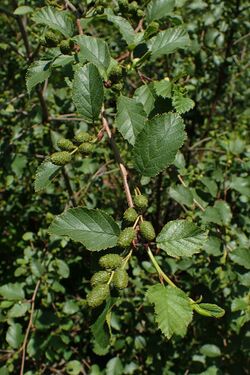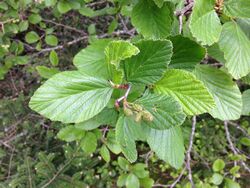Biology:Alnus alnobetula
| Alnus alnobetula | |
|---|---|

| |
| Scientific classification | |
| Kingdom: | Plantae |
| Clade: | Tracheophytes |
| Clade: | Angiosperms |
| Clade: | Eudicots |
| Clade: | Rosids |
| Order: | Fagales |
| Family: | Betulaceae |
| Genus: | Alnus |
| Subgenus: | Alnus subg. Clethropsis |
| Species: | A. alnobetula
|
| Binomial name | |
| Alnus alnobetula (Ehrh.) K.Koch
| |

| |
| Natural distribution of Alnus viridis complex | |
| Synonyms[2] | |
|
List
| |
Alnus alnobetula is a common tree widespread across much of Europe, Asia, and North America.[2] Many sources refer to it as Alnus viridis, the green alder, but botanically this is considered an illegitimate name synonymous with Alnus alnobetula subsp. fruticosa.[3]
Description
It is a large shrub or small tree 3–12 metres (10–39 1⁄2 ft) tall with smooth grey bark even in old age. The leaves are shiny green with light green undersurfaces, ovoid, 3–8 centimetres (1 1⁄4–3 1⁄4 in) long and 2–6 cm broad. The flowers are catkins, appearing late in spring after the leaves emerge (unlike other alders which flower before leafing out); the male catkins are pendulous, 4–8 cm long, the female catkins 1 cm long and 0.7 cm broad when mature in late autumn, in clusters of 3–10 on a branched stem.[4] The seeds are small, 1–2 millimetres (1⁄32–3⁄32 in) long, light brown with a narrow encircling wing.
The roots of Alnus viridis subsp. sinuata have nitrogen-fixing nodules.[5] A study in Alaska showed that Sitka alder seedlings were able to invade coal mine spoils and can be used for revegetation and stripmine reclamation.[6]
Distribution
There are four to six subspecies, some treated as separate species by some authors:[7]
- Alnus viridis subsp. viridis – Central Europe
- Alnus viridis subsp. suaveolens – Corsica (endemic)
- Alnus viridis subsp. fruticosa – Northeast Europe, northern Asia, northwestern North America
- Alnus viridis subsp. maximowiczii (A. maximowiczii) – Japan
- Alnus viridis subsp. crispa (A. crispa, mountain alder) – northeastern North America, Greenland
- Alnus viridis subsp. sinuata (A. sinuata, Sitka alder or slide alder) – western North America, far northeastern Siberia
Alnus viridis is classed as an environmental weed in New Zealand.[8]
Ecology
Alnus viridis has a shallow root system, and is marked not only by vigorous production of stump suckers, but also by root suckers.
Alnus viridis is a light-demanding, fast-growing shrub that grows well on poorer soils. In many areas, it is a highly characteristic colonist of avalanche chutes in mountains, where potentially competing larger trees are killed by regular avalanche damage. A. viridis survives the avalanches through its ability to re-grow from the roots and broken stumps. Unlike some other alders, it does require moist soil, and is a colonist of screes and shallow stony slopes. It also commonly grows on subarctic river gravels, particularly in northern Siberia, Alaska and Canada , occupying areas similarly disrupted by ice floes during spring river ice breakup; in this habitat it commonly occurs mixed with shrubby willows.
Uses
It is sometimes used for afforestation on infertile soils which it enriches by means of its nitrogen-fixing nodules, while not growing large enough to compete with the intended timber crop. A. sinuata can add 20 kg of nitrogen per acre (50kg/hectare) per year to the soil.[9] Alnus viridis leaves have been used in the traditional Austrian medicine externally or internally as tea for treatment of infections and fever.[10]
References
- ↑ Rivers, M.C.; Stritch, L. (2016). "Alnus alnobetula". The IUCN Red List of Threatened Species (IUCN) 208: e.T51203944A2347475.. doi:10.2305/IUCN.UK.2016-1.RLTS.T51203944A2347475.en.
- ↑ 2.0 2.1 Kew World Checklist of Selected Plant Families
- ↑ Govaerts, R. (2003). World Checklist of Selected Plant Families Database in ACCESS: 1-216203. The Board of Trustees of the Royal Botanic Gardens, Kew.
- ↑ Furlow, John J. (1997), "Alnus viridis", in Flora of North America Editorial Committee, Flora of North America North of Mexico (FNA), 3, New York and Oxford, http://www.efloras.org/florataxon.aspx?flora_id=1&taxon_id=233500041
- ↑ Patterson, Patricia A. (1985). Field Guide to the Forest Plants of Northern Idaho. United States Department of Agriculture Forest Service. p. 35. https://www.fs.fed.us/rm/pubs_int/int_gtr180.pdf.
- ↑ "Fire Effects Information System (FEIS)". USDA. https://www.fs.fed.us/database/feis/plants/shrub/alnvirs/all.html.
- ↑ Template:Flora Europaea
- ↑ Clayson, Howell (May 2008). Consolidated list of environmental weeds in New Zealand. Wellington: Department of Conservation. ISBN 978-0-478-14412-3.
- ↑ Ewing, Susan (1996). The Great Alaska Nature Factbook. Portland: Alaska Northwest Books.
- ↑ Vogl, S; Picker, P; Mihaly-Bison, J; Fakhrudin, N; Atanasov, A. G.; Heiss, E. H.; Wawrosch, C; Reznicek, G et al. (2013). "Ethnopharmacological in vitro studies on Austria's folk medicine--an unexplored lore in vitro anti-inflammatory activities of 71 Austrian traditional herbal drugs". Journal of Ethnopharmacology 149 (3): 750–71. doi:10.1016/j.jep.2013.06.007. PMID 23770053.
External links
- Alnus viridis - information, genetic conservation units and related resources. European Forest Genetic Resources Programme (EUFORGEN)
Wikidata ☰ {{{from}}} entry
 |



